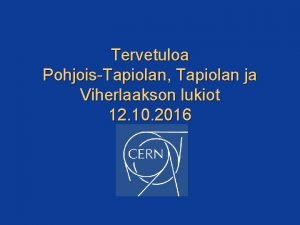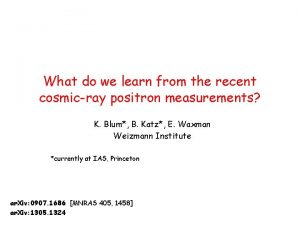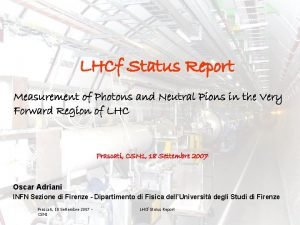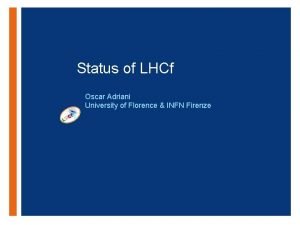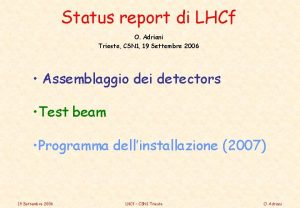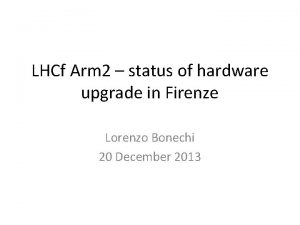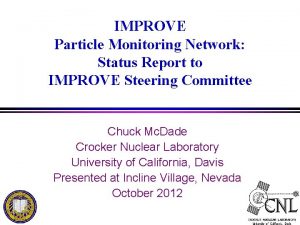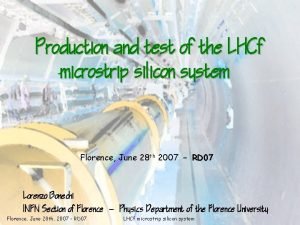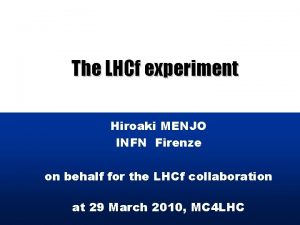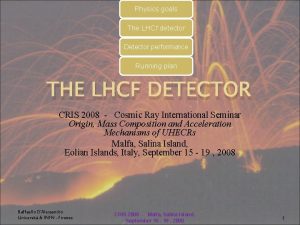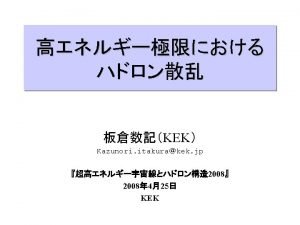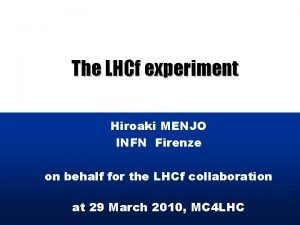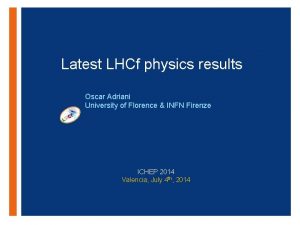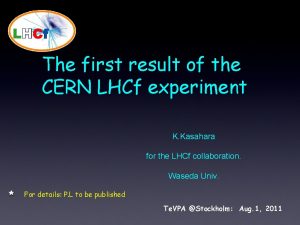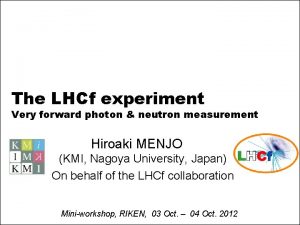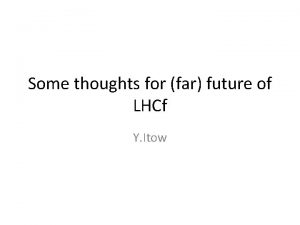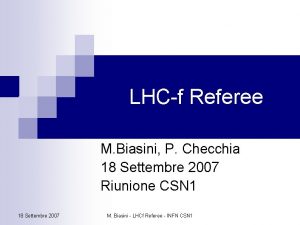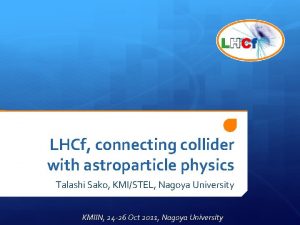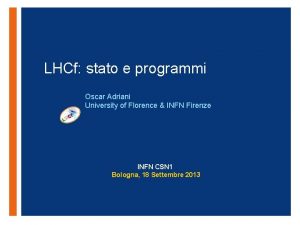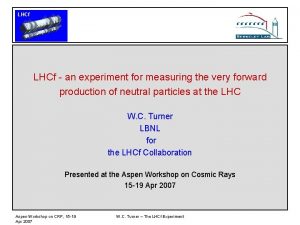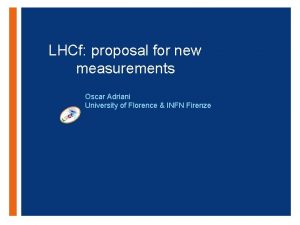Recent status of LHCf to improve the cosmicray































- Slides: 31

Recent status of LHCf to improve the cosmic-ray air shower modeling Takashi SAKO (KMI/STEL, Nagoya University) for the LHCf Collaboration KMI 2013@Nagoya 1 13 -Dec-2013

Outline Standard Scenario of the Cosmic-Ray Spectrum LHCf Experiment Overview Results Future Summary 2

Flux Standard Scenario of the Cosmic-Ray Spectrum proto n Heliu m Ligh t ion s Heav y ion s Acceleration limit of SNR approx. 4 x 1015 V Rigidity (pc/Z) Cosmic-ray accelerators = Pe. Vatrons have finite size and B field => Acceleration limit same in rigidity for different nuclei 3

Flux Standard Scenario of the Cosmic-Ray Spectrum proto n Heliu m Ligh t ion s Heav y ion s Energy In term of ‘Energy, ’ heavier particles have Z times higher energy than protons 4

Flux Standard Scenario of the Cosmic-Ray Spectrum Scale-up for Extra-Galactic sources Galactic CRs Energy Over GCR max energy, Extra-galactic CRs appear 5

Standard Scenario of the Cosmic-Ray Spectrum Flux knee ankle (GZK) cutoff Energy 1015 e. V 1018 e. V Questions End of GCR Turn over from GCR to EGCR Cutoff (acc. Limit, proton GZK, ion GZK) 6 1020 e. V

knee heavy ankle mass Flux Standard Scenario of the Cosmic-Ray Spectrum ? (GZK) cutoff light (=proton) 1015 e. V Energy 1018 e. V Mass vs. Energy Light below knee Light to heavy over knee Heavy to light around ankle Light or light to heavy around 7 cutoff 1020 e. V

heavy ankle mass Flux knee ? (GZK) cutoff light (=proton) 1015 e. V Energy 1018 e. V Mass vs. Energy Light < knee Light to heavy over knee Heavy to light around ankle Light or light to heavy around 8 cutoff 1020 e. V

QGSJET 1 SIBYLL QGSJETII letter-to-PAC_20131206 letter-to-PHENIX_2013120 EPOS (Kampert and Unger, Astropart. Phys. , 2012) 9 Interpretation depends on the hadronic interaction model

① Inelastic cross section If large s rapid development If small s deep penetrating ④ 2 ndary interactions nucleon, p ② Forward energy spectrum Soft interaction (non-perturbative QCD) dominates If softer Various phenomenological modelsshallow are proposed development (keywords: Regge theory, multi-Pomeron interaction, If harder. Glauber theory) deep penetrating Experimental inputs are important LHC gives the best opportunity ③ Inelasticity k= 1 -plead/pbeam If large k (π0 s carry more energy) rapid development If small k ( baryons carry more energy) deep penetrating 10

ry 2 particle flow at colliders multiplicity and energy flux at LHC 14 Te. V collisions Energy Flux Multiplicity All particles neutral ü Most of the energy flows into very forward ü √s=14 Te. V pp collision corresponds to Elab=1017 e. V 11 11

Large Hadron Collider forward (LHCf) 12

The LHCf experiment (Oct. 2013 -) *Y. Itow, K. Kawade, Y. Makino, K. Masuda, Y. Matsubara, E. Matsubayashi, Y. Muraki, *T. Sako, *N. Sakurai, Y. Sugiura, Q. D. Zhou Solar-Terrestrial Environment Laboratory, Nagoya University, Japan *Kobayashi-Maskawa Institute, Nagoya University, Japan Graduate School of Science, Nagoya University, Japan Shibaura Institute of Technology, Japan H. Menjo (-Mar 2013) K. Yoshida K. Kasahara, Y. Shimizu, T. Suzuki, S. Torii Waseda University, Japan Kanagawa University, Japan Ecole Polytechnique, France LBNL, Berkeley, USA T. Tamura M. Haguenauer W. C. Turner O. Adriani, L. Bonechi, M. Bongi, R. D’Alessandro, M. Delprete, M. Grandi, G. Mitsuka, P. Papini, S. Ricciarini, G. Castellini A. Tricomi J. Velasco, A. Faus A-L. Perrot INFN, Univ. di Firenze, Italy INFN, Univ. di Catania, Italy IFIC, Centro Mixto CSIC-UVEG, Spain CERN, Switzerland

The LHC forward experiment LHCf Arm#1 ATLAS 140 m Two independent detectors at either side of IP 1 (Arm#1, Arm#2 ) Beam 96 mm Beam pipe Charged particles (+) Neutral particles LHCf Arm#2 Charged particles (-) ü All charged particles are swept by dipole magnet ü Neutral particles (photons and neutrons) arrive at LHCf 14 ü 0 degree is covered

LHCf Detectors ü Imaging sampling shower calorimeters ü Two calorimeter towers in each of Arm 1 and Arm 2 ü Each tower has 44 r. l. of Tungsten, 16 sampling scintillator and 4 position sensitive layers Arm#1 Detector 20 mmx 20 mm+40 mmx 40 mm 4 XY Sci. Fi+MAPMT Arm#2 Detector 25 mmx 25 mm+32 mmx 32 mm 4 XY Silicon strip detectors 15

Done LHCf Status 0. 9, 2. 76, 7 Te. V pp collision, 5 Te. V p. Pb collision data taking Photon spectra at 0. 9 and 7 Te. V published π0 spectra at 7 Te. V published Performance at 0. 9 and 7 Te. V published On going Neutron spectra at 7 Te. V π0 and UPC spectra at 5 Te. V p. Pb Rad-hard detector upgrade for 13 Te. V pp Plan 13 Te. V pp collision in 2015 (operation plan in discussion) 0. 5 Te. V pp at RHIC (LOI submitted) 16 Discussions for light ion collision at RHIC and LHC

Photon spectra @ 7 Te. V (Data vs. Models) Adriani et al. , PLB, 703 (2011) 128 -134 Around 0 degree (On axis) Off axis DPMJET 3. 04 QGSJET II-03 SIBYLL 2. 1 EPOS 1. 99 PYTHIA 8. 145 17

Photon spectra @ 900 Ge. V Adriani et al. , PLB, 715 (2012) 298 -3 18

900 Ge. V vs. 7 Te. V XF spectra : 900 Ge. V data vs. 7 Te. V data Preliminary Data 2010 at √s=900 Ge. V (Normalized by the number of entries in XF > 0. 1) Data 2010 at √s=7 Te. V (η>10. 94) Comparison in the same p. T range (p. T<0. 13 x. F Ge. V/c) ü Normalized by # of events XF > 0. 1 ü Statistical error only ü 19

π0 analysis Longitudinal development Small Cal. • π0 candidate • 599 Ge. V & 419 Ge. V photons in 25 mm and 32 mm tower, respectively • M = θ√(E 1 x. E 2) Large Cal. Lateral development γ 1(E 1) Silicon X R 140 m γ 2(E 2) Silicon Y 20 θ I. P. 1

π0 p. T distribution in different rapidity (y) ranges Adriani et al. , PRD, 86, 092001 (2012) 21

Confirmation of x. F scaling Events selected from very narrow phase space to compare with 900 Ge. V result LHCf@RHIC=RHICf 500 Ge. V 2 1 E (Ge. V) Phase space of LHC 7 Te. V data p. T (Ge. V/c) Phase space of LHC 900 Ge. V data p. T (Ge. V/c) Preliminary Color map: photon production rate Red triangle: LHCf acceptance 0 10022 200 E (Ge. V)

Cosmic-ray spectrum & Colliders Knee: end of galactic proton CR End of galactic CR and transition to extra-gal CR Ankle (GZK) cutoff: end of CR spectru 1010 23 LHC 7 Te. V LHC 13 Te. V RHIC Spp. S LHC 0. 9 Te. V Tevatron ISR 1020 e. V

011 2 E in IIN D I SL t KM a Next Step of LHCf Analysis In progress/assured Impact on air shower calculation / CR physics In consideration Photon spectra at √s = 0. 9 Te. V in analysis π0 spectra in analysis PT spectra Hadron spectra (photon/hadron ratio) Test for LPM effect Correlation with central production (joint analysis with ATLAS) Measurements LHC √s = 14 Te. V pp LHC p-Pb in study Possibility in the other colliders Dream : N-p, N-N, N-Fe (N; Nitrogen) in future 24

Next Step of LHCf Analysis In progress/assured In consideration Impact on air shower calculation / CR physics Dr. Sakurai joined Done! Photon spectra at √s = 0. 9 Te. V in analysis Done! π0 spectra in analysis PT spectra Complete soon Hadron spectra (photon/hadron ratio) Baryon Test for LPM effect Correlation with central production (joint analysis with ATLAS) Measurements PRIME TARGET LHC √s = 14 Te. V pp Preparation on going LHC p-Pb in study Operation done! Analysis on going Possibility in the other colliders LOI to RHIC Dream : N-p, N-N, N-Fe (N; Nitrogen) in future 25 Discussion at RHIC and LHC

43 participants 13 from abroad LHCf TOTEM ALICE CMS PHENIX Cosmic Ray Diffraction CGC UPC Interaction Model 26

Summary Determination of the CR mass (chemical) composition is important to understand the CR origin LHCf is motivated to constrain the hadronic interaction models used to interpret the cosmic-ray air shower data Successful operations at LHC p-p and p-Pb collisions Three physics publications and some ongoing analysis No surprise so far but set strong constraints to the models Preparation for the highest energy operation in progress Discussions for future plan started RHIC; validation of Feynman scaling RHIC; first light ion collision LHC; highest energy light ion collision 27

Backup 28

29

900 Ge. V vs. 7 Te. V XF spectra : 900 Ge. V data vs. 7 Te. V data LHCf coverage in XF-p. T plane (XF = E/Ebeam) 900 Ge. V vs. 7 Te. V with the same PT region s 0. 1 ll-η a m = e rg a L Preliminary er w to er all tow m S = big-η Data 2010 at √s=900 Ge. V (Normalized by the number of entries in XF > 0. 1) Data 2010 at √s=7 Te. V (η>10. 94) 900 Ge. V Small+large tower Normalized by # of evnets. XF > 0. 1 ü Statistical error only ü Good agreement of XF spectrum shape between 900 Ge. V and 7 Te. V. 30

x. F scaling : a key for extrapolation Expected from models (5 Te. V, 14 Te. V and 50 Te. V) LHC single gamma data (900 Ge. V pp / 7 Te. V pp) Data Preliminary 0. 9 Te. V (h>8. 68) 7 Te. V scaled (h>10. 94) But this comparison done in very limited phase space. . 31
 Lhcf
Lhcf Stippling
Stippling Recent developments in object detection
Recent developments in object detection Recent news in passive voice
Recent news in passive voice Emerging trends in mis
Emerging trends in mis Recent trends in project management
Recent trends in project management After miguel's recent automobile accident
After miguel's recent automobile accident Many recent college graduates have faced
Many recent college graduates have faced Https drive google com drive u 0 recent
Https drive google com drive u 0 recent Recent demographic changes in the uk
Recent demographic changes in the uk Recent trends in ic engine
Recent trends in ic engine A friend emails you the results
A friend emails you the results Http drive google com
Http drive google com Types of international trade
Types of international trade Myips.schoology
Myips.schoology Recent developments in ict
Recent developments in ict Recent advances in dental ceramics
Recent advances in dental ceramics Udin generate icsi
Udin generate icsi What is skimming and scanning
What is skimming and scanning Thế nào là hệ số cao nhất
Thế nào là hệ số cao nhất Trời xanh đây là của chúng ta thể thơ
Trời xanh đây là của chúng ta thể thơ Frameset trong html5
Frameset trong html5 Hệ hô hấp
Hệ hô hấp Số nguyên tố là gì
Số nguyên tố là gì đặc điểm cơ thể của người tối cổ
đặc điểm cơ thể của người tối cổ Các châu lục và đại dương trên thế giới
Các châu lục và đại dương trên thế giới Tư thế worms-breton
Tư thế worms-breton ưu thế lai là gì
ưu thế lai là gì Tư thế ngồi viết
Tư thế ngồi viết Cái miệng xinh xinh thế chỉ nói điều hay thôi
Cái miệng xinh xinh thế chỉ nói điều hay thôi Các châu lục và đại dương trên thế giới
Các châu lục và đại dương trên thế giới Mật thư anh em như thể tay chân
Mật thư anh em như thể tay chân
